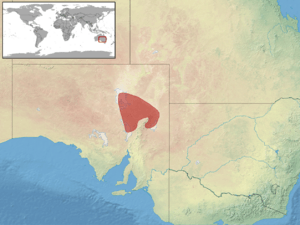Lake Eyre dragon facts for kids
Quick facts for kids Lake Eyre dragon |
|
|---|---|
| Conservation status | |
| Scientific classification | |
| Genus: |
Ctenophorus
|
| Species: |
maculosus
|
 |
|
The Ctenophorus maculosus, also known as the Lake Eyre dragon or salt-lake ground-dragon, is a type of lizard. It belongs to the Agamidae family, which includes many types of dragons and agamas. This lizard is found only in South Australia. This means it is endemic to that area.
The Lake Eyre dragon mostly lives near the edges of salt lakes in South Australia. Its common names come from this special habitat. It can survive in this tough environment. It has special ways to handle very hot temperatures and a lack of fresh water. Female Lake Eyre dragons also have unique ways to avoid male lizards. Scientists are still studying these interesting behaviors.
Contents
What Does the Lake Eyre Dragon Look Like?
The Lake Eyre dragon has a white or light grey back. It also has black spots. Its belly is white with a dark line down the middle. You can see black and brown spots all over its body. This special coloring helps the lizard blend in with the salt surface where it lives. This is called cryptic coloration. The colors can change a bit depending on where the lizard lives.
Adult male dragons are about 11.5 cm (4.5 inches) long. This measurement includes their tail. Adult females are a little shorter, around 10.0 cm (3.9 inches).
This lizard has small eyes that are set deep into its head. Its eyelids have a jagged edge, which helps protect its eyes. Its nostrils are connected to its nose by a narrow slit. This nose shape helps stop sand from blocking its nose when it burrows. Other lizards that dig in sand, like some in America, have also developed similar nose shapes. This is an example of convergent evolution. It means different animals develop similar features to solve the same problem.
Where Do Lake Eyre Dragons Live?
The Lake Eyre dragon is found only in South Australia. It lives around the three biggest dry salt lakes there. These lakes are Lake Eyre, Lake Callabonna, and Lake Torrens. The largest number of these lizards live around Lake Eyre.
These lizards need a special kind of home. Their habitat has three main features:
- A hard crust on the surface.
- A thick layer of dry sand or clay under the crust.
- A constant source of moisture below the surface.
The Lake Eyre dragon lives at the edges of these lakes. It digs burrows in the damp soil under the salt crust.
What Do Lake Eyre Dragons Eat?
The main food for the Lake Eyre dragon is a type of ant called the harvest ant (Melophorus). The ant nests are also helpful for the lizards. They use the ant mounds as high spots to look out from. They also use them for sunbathing and finding shade.
The Lake Eyre dragon is an opportunistic feeder. This means it will eat other insects too. It often eats insects that get stuck on the salt surface.
How Do Lake Eyre Dragons Behave?
How They Adapt to Their Home
The Lake Eyre dragon has developed special behaviors. These help it deal with the tough conditions of its environment. It acts much like other animals that live in deserts.
It uses different body positions and movements. This helps it keep its body at the best temperature. This is called maintaining an optimal body temperature. Its body has also changed to deal with not having much water. It loses very little water from its body. This is because it has a low evaporation rate.
Images for kids



